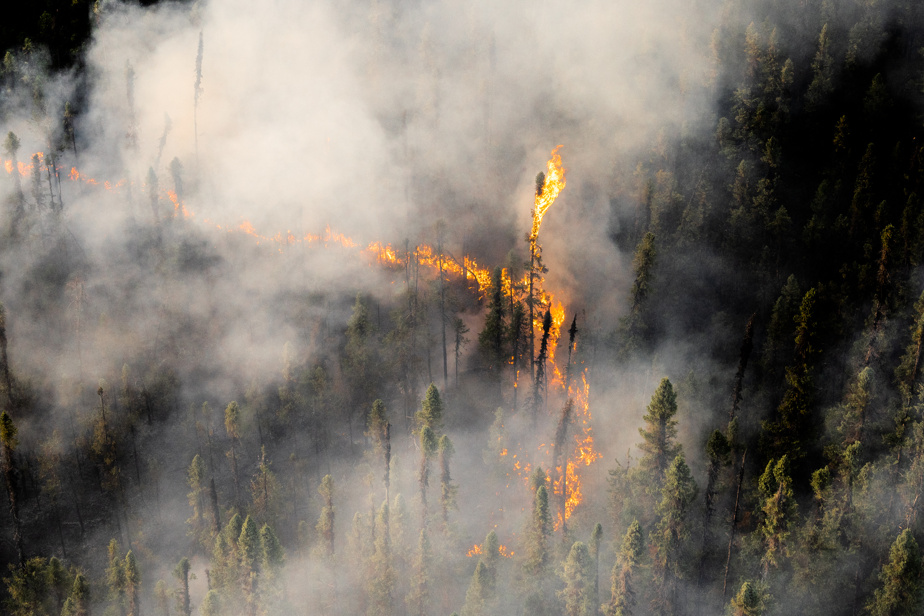(Ottawa) More than three-quarters of the 70 wildfires already burning in the west and north of the country started in 2023 and have never been extinguished. Abnormally warm temperatures and little precipitation raise fears of an early season this year. In Ottawa, the government has been preparing since January, five months earlier than planned.
What there is to know
In 2023, Canada experienced its worst wildfire season.
They had ravaged 15 million hectares.
This year, 70 fires are already burning in the west and north of the country, some of which never went out during the winter.
“Many of these are persistent 2023 fires that smoldered during the warm, dry winter we experienced and became more active as the spring progressed,” explained Michael Norton, executive director of the Center for Northern Forestry of the Ministry of Natural Resources, during an information session Wednesday.
In all, there are 55 fires in 2023 out of the 70 active fires burning in northern British Columbia, northern Alberta and the southern Northwest Territories.
“There are deeper organic layers, namely peat, which can reach a depth of 40 centimeters or more. And what happens is the fire can smolder underground about 10, 20, 30 centimeters while there’s still snow on the ground,” says Professor Mike Flannigan, of Thompson Rivers University. in British Columbia, specializing in the study of forest fires.
“It burns very slowly, but continues to burn all winter if conditions are favorable,” he adds.
That’s what happened during the 2016 fire that ravaged Fort McMurray, Alberta. It was only completely turned off the following summer, in 2017.
Dormant fires
This year, smoke has already been seen crossing highways in the middle of winter in northern British Columbia, a sign that these underground fires are numerous, notes Professor Mike Flannigan.
He notes that these dormant fires are common and aren’t usually a problem, but they could quickly become one this time. Last year’s fires were numerous and sometimes reached “the size of Prince Edward Island”, leaving many of these “hot spots” behind.
[Les incendies en dormance] can spread if the wind picks up and the weather is hot and dry.
Mike Flannigan, professor at Thompson Rivers University in British Columbia
However, the specialist does not expect to see a season as devastating as last year again “in his lifetime”.
Regardless, the government is preparing for an equivalent season if not worse. “We can expect the wildfire season to start earlier, end later and potentially be more explosive,” Canadian Emergency Preparedness Minister Harjit Sajjan bluntly stated at a conference press release to take stock of the situation.
Other fires are likely to break out in western Quebec, northern Ontario, the Prairies and eastern and southern British Columbia with warmer than normal temperatures and little rain and snow that fell to the ground during the winter.
Eleven provinces and territories have reached an agreement with the federal government to obtain a share of the 256 million over five years allocated in the 2022 budget. The Minister of Natural Resources, Jonathan Wilkinson, was hopeful on Wednesday of reaching an agreement with Quebec soon.
Lessons learned
Canada experienced its worst wildfire season last year, which destroyed 15 million hectares and led to the evacuation of 230,000 people. In total, 6,623 fire outbreaks were recorded across the country.
“We learned lessons from last year and we are doing things differently this year,” acknowledged the Minister of Indigenous Services, Patty Hajdu.
Last year, 82 indigenous communities across the country had to be evacuated due to forest fires. The Press had visited in May that of Sturgeon Lake, in Alberta, where dozens of houses had been razed by the flames.

PHOTO MARTIN CHAMBERLAND, LA PRESSE ARCHIVES
Destruction in the Cree community of Sturgeon Lake, Alberta, during wildfires in spring 2023
The government announced Wednesday $166.2 million over the next five years to help First Nations deal with natural disasters. The advance payment program to enable indigenous communities to prepare is being extended across the country. The federal government will also fund 48 emergency management coordinator positions, one in each of Alberta’s Indigenous communities to carry out this preparedness work. This brings the total number of such coordinators to 248 nationwide.
Furthermore, the government will double the tax credit for volunteer firefighters and search and rescue volunteers in its next budget. This credit will increase from $3,000 to $6,000 in 2024. This measure aims to put $900 back into the pockets of volunteer firefighters who work in small communities. The government estimates that it will cost a total of 105 million over six years.
Attacks on Poilievre
The four Trudeau government ministers present at the press conference repeatedly attacked Conservative leader Pierre Poilievre and his offensive against the carbon tax. They have repeatedly highlighted the link between climate change and the scale of forest fires.
“Why do we still need to debate the reality of climate change in Canada? », asked the Minister of the Environment, Steven Guilbeault.
The Conservatives wanted to pass a motion to force a meeting of prime ministers on the carbon tax and other measures that could be put in place to fight climate change. They consider it a “financial burden” for Canadians, but fail to mention that the government is sending a check to offset its cost.
A modified version of the motion, which recognizes that Quebec has its own system, was adopted 173 to 149 thanks to the support of the Bloc Québécois and the New Democratic Party. The Conservatives have been suggesting for months that the federal carbon tax applies to Quebec even though it has its own carbon market jointly with California.
The motion states that the prime ministers’ meeting must take place within five weeks. However, it is non-binding.
